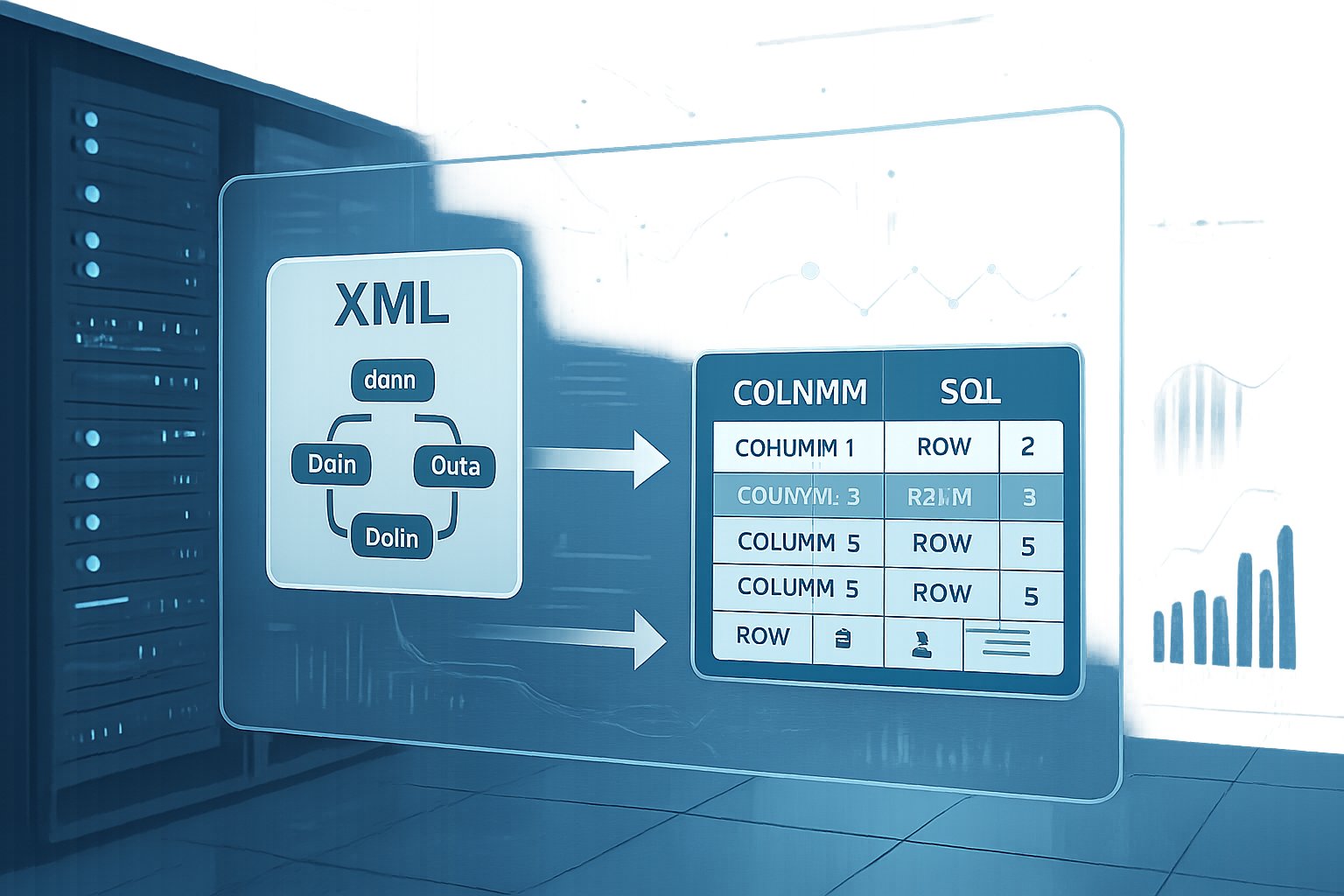XML data has become essential for modern analytics, and SQL Server provides powerful built-in tools to handle this semi-structured data format. Many organizations store configuration files, web service responses, and complex data structures in XML format, making it crucial for analysts to extract meaningful insights from these sources.

SQL Server’s native xml data type and XQuery capabilities allow analysts to store, query, and transform XML data directly within their relational databases without external tools. This integration eliminates the need for complex data pipelines and enables real-time analysis of XML content alongside traditional structured data.
Understanding how to leverage SQL Server’s XML features can transform how analysts approach semi-structured data challenges. From basic storage and indexing to advanced querying techniques and performance optimization, mastering these capabilities opens new possibilities for comprehensive data analysis and reporting workflows.
Key Takeaways
- SQL Server’s native xml data type enables direct storage and querying of XML data within relational databases
- XQuery and built-in XML functions provide powerful tools for extracting and transforming XML data for analytics
- Proper indexing and optimization techniques significantly improve performance when working with large XML datasets
Understanding XML in SQL Server

XML (Extensible Markup Language) serves as a standardized format for storing and exchanging data in SQL Server environments. SQL Server provides native support for XML through dedicated data types, storage methods, and querying capabilities that bridge the gap between relational databases and document-based data structures.
What Is XML and Extensible Markup Language?
XML stands for Extensible Markup Language. It is a markup language that defines rules for encoding documents in a format that is both human-readable and machine-readable.
XML uses tags to structure data in a hierarchical format. Each piece of information gets wrapped in opening and closing tags that describe what the data represents.
The language is called “extensible” because users can create their own custom tags. This flexibility makes XML ideal for describing different types of data structures.
Key XML characteristics include:
- Self-describing data through meaningful tag names
- Platform-independent format
- Hierarchical structure with parent and child elements
- Support for attributes within elements
XML documents must follow specific syntax rules to be well-formed. They need a single root element that contains all other elements.
How SQL Server Supports XML Data
SQL Server provides built-in support for XML through the xml data type. This native data type allows developers to store XML documents directly in database columns.
The xml data type can be typed or untyped. Typed XML columns validate data against XML schema collections. Untyped columns accept any well-formed XML document.
SQL Server XML features include:
- Native xml data type for column storage
- XML indexing for improved query performance
- XQuery support for querying XML data
- Built-in functions for XML manipulation
Developers can store XML values in xml columns and apply indexes to improve query performance. The database engine validates XML documents when they are inserted.
SQL Server also provides methods to convert relational data to XML format using FOR XML clauses. The FOR XML AUTO and FOR XML PATH options generate XML documents from table data.
Advantages of XML for Data Exchange
XML offers significant benefits for data exchange between different systems and platforms. Its text-based format makes it readable across various operating systems and applications.
The self-describing nature of XML eliminates the need for separate documentation about data structure. Tag names provide context about what each data element represents.
Primary XML advantages:
- Platform independence – Works across different systems
- Human readable – Easy to understand and debug
- Extensible – Can accommodate new data requirements
- Standardized – Follows established industry standards
XML supports complex data structures including nested elements and attributes. This flexibility allows it to represent both simple and complex business data.
The format handles semi-structured data well. Organizations can use XML when data doesn’t fit neatly into traditional relational table structures.
Relational Data vs. XML Documents
Relational databases organize data into tables with rows and columns. Each table represents an entity, and relationships connect tables through foreign keys.
XML documents use a hierarchical structure with nested elements. Data gets organized in a tree-like format with parent-child relationships.
| Relational Data | XML Documents |
|---|---|
| Tabular structure | Hierarchical structure |
| Fixed schema | Flexible schema |
| Normalized data | Can contain redundant data |
| SQL queries | XQuery for querying |
Relational data excels at handling structured data with clear relationships. It enforces data integrity through constraints and normalization rules.
XML works better for semi-structured or variable data formats. It can represent complex nested relationships that don’t map well to flat table structures.
SQL Server bridges both approaches by allowing XML storage within relational tables. This hybrid approach lets developers use the best features of each data model.
Storing and Managing XML Data

SQL Server provides native XML data type support for storing structured and semi-structured data directly in database tables. Users can define XML columns, store complex hierarchical records, and modify XML content using built-in functions and methods.
Defining XML Columns and XML Data Type
The xml data type in SQL Server allows developers to store XML documents and fragments natively in database tables. This data type supports both typed and untyped XML storage options.
When creating XML columns, developers can specify whether the column should be typed or untyped. Typed XML columns use XML schema collections to validate data structure. Untyped columns accept any well-formed XML content without validation.
CREATE TABLE Products (
ProductID int PRIMARY KEY,
ProductInfo xml,
ValidatedSpecs xml(ProductSchema)
);SQL Server automatically indexes XML columns to improve query performance. The database engine compresses off-row XML data to reduce storage requirements.
XML columns can store up to 2GB of data per row. Large XML documents get stored off-row automatically when they exceed certain size thresholds.
Storing Hierarchical and Nested Records
XML data type excels at storing hierarchical structures that don’t fit well in traditional relational tables. Developers can store complex nested records with varying attributes and child elements.
Product catalogs, configuration files, and user preferences often contain nested data structures. XML columns handle these scenarios without requiring complex join tables or normalization.
INSERT INTO Products (ProductID, ProductInfo) VALUES
(1, '<product>
<specifications>
<category>Electronics</category>
<features>
<feature name="color">Blue</feature>
<feature name="weight">2.5kg</feature>
</features>
</specifications>
</product>');The hierarchical nature of XML allows for flexible data models. New attributes and elements can be added without changing table schemas.
Modifying XML Data in Tables
SQL Server provides several methods for modifying XML data stored in tables. The modify() method allows developers to insert, update, and delete XML nodes directly.
Users can insert new elements using the insert keyword within the modify() method. This approach adds content to existing XML documents without replacing entire values.
UPDATE Products
SET ProductInfo.modify('insert <warranty>2 years</warranty>
into (/product/specifications)[1]')
WHERE ProductID = 1;The replace value of statement updates existing XML node values. Developers can change specific attributes or element content without affecting other parts of the document.
Delete operations remove XML nodes using XPath expressions. This method provides precise control over which elements or attributes get removed from stored XML data.
Querying and Extracting Insights from XML

SQL Server provides several methods for querying XML data, including T-SQL functions, XPath expressions, and XQuery syntax. The nodes() function offers an efficient approach for extracting multiple values from complex XML structures.
Querying XML Data with T-SQL
SQL Server includes built-in methods for working with XML data stored in xml columns. The value() method extracts single values from XML documents. The query() method returns XML fragments.
The exist() method checks if specific elements or attributes exist in the XML. This method returns 1 if the element exists and 0 if it does not.
SELECT ID,
XMLData.value('(/order/customer)[1]', 'varchar(50)') AS Customer
FROM Orders
WHERE XMLData.exist('/order/total') = 1These methods work directly with XML columns in SELECT, WHERE, and JOIN clauses. They integrate XML querying with standard T-SQL operations.
Using XPath and XQuery
XPath expressions locate elements and attributes within XML documents. XQuery provides a more powerful language for complex XML queries. Both work together in SQL Server’s XML methods.
XPath uses path notation similar to file system paths. Forward slashes separate element levels. Square brackets filter results based on conditions.
-- XPath examples
'/order/items/item[1]' -- First item
'//product[@id="123"]' -- Product with specific ID
'/order/customer/text()' -- Customer text contentXQuery extends XPath with additional features like FLWOR expressions. It supports more complex data transformations and filtering operations.
XQuery handles namespaces, data type conversions, and conditional logic. It works well for extracting insights from complex XML structures.
Efficient Querying with the nodes() Function
The nodes() method creates a rowset from XML data. It works best when extracting multiple values from repeating XML elements. This approach performs better than multiple individual value() calls.
The nodes() function returns references to XML nodes. Each reference can use additional XML methods like value() and exist().
SELECT
Product.value('(@id)[1]', 'int') AS ProductID,
Product.value('(name)[1]', 'varchar(100)') AS ProductName,
Product.value('(price)[1]', 'decimal(10,2)') AS Price
FROM Catalog
CROSS APPLY XMLData.nodes('/catalog/product') AS T(Product)This method scales better than OpenXML for most scenarios. It uses XML indexes effectively and integrates with the query processor. The combination of nodes() and value() provides the most efficient approach for extracting rowsets from XML data.
Transforming and Exchanging Data

SQL Server provides three main approaches for converting between XML and relational formats: FOR XML transforms table data into XML documents, OPENXML converts XML into rows and columns, and OPENROWSET enables bulk XML data import operations.
Using FOR XML for Data Transformation
The FOR XML clause converts relational data into XML format directly within SQL queries. This method works with any SELECT statement to create XML documents from database tables.
FOR XML offers four main modes for data transformation. The RAW mode creates one XML element per row. The AUTO mode builds nested XML based on table relationships. The EXPLICIT mode gives full control over XML structure. The PATH mode uses XPath expressions for element naming.
Data transformation becomes simple with FOR XML PATH. Users can specify custom element names and create nested structures. The clause handles NULL values automatically and converts data types to appropriate XML formats.
SELECT CustomerID, CompanyName, ContactName
FROM Customers
FOR XML PATH('Customer'), ROOT('Customers')This approach eliminates the need for external XML generation tools. Database administrators can create XML documents directly from existing relational data without additional processing steps.
Shredding XML to Relational Data
XML shredding breaks down XML documents into separate columns and rows for relational storage. SQL Server uses XQuery methods to extract specific values from XML data types.
The xml data type supports several key methods for data extraction. The value() method retrieves single scalar values. The query() method returns XML fragments. The exist() method checks for element presence. The nodes() method creates rowsets from XML elements.
SELECT
T.c.value('(IdInvernadero)[1]', 'int') AS GreenhouseID,
T.c.value('(IdProducto)[1]', 'int') AS ProductID
FROM @xml.nodes('/row') T(c)XQuery expressions define the path to specific XML elements. Square brackets specify position numbers for multiple elements. Data type conversion happens automatically during the extraction process.
Shredding works best with structured XML documents that follow consistent patterns. Complex nested structures may require multiple extraction steps to capture all relevant data.
OPENXML and OPENROWSET for Data Import
OPENXML creates relational views of XML documents stored in memory. This function requires XML document preparation using sp_xml_preparedocument before data extraction begins.
The function uses three main parameters: document handle, XPath expression, and column definitions. OPENXML supports attribute and element-based XML structures through different flag values.
EXEC sp_xml_preparedocument @handle OUTPUT, @xmldata
SELECT * FROM OPENXML(@handle, '/root/row', 2)
WITH (ID int, Name varchar(50))OPENROWSET enables bulk XML data import from files or web sources. This method loads large XML documents directly into SQL tables without intermediate processing steps.
The BULK provider reads XML files from disk locations. Users specify file paths and format options for data import operations. OPENROWSET works well for regular XML data loads and integration processes.
Both functions handle data exchange between external systems and SQL databases. They support various XML formats and provide flexible mapping options for different data structures.
Optimizing XML Performance and Indexing
XML data in SQL Server requires proper indexing strategies to achieve good performance. Creating the right index types and following best practices can reduce query times from hours to seconds.
Implementing XML Indexes
XML indexes improve query performance by creating internal tables that store XML data in a searchable format. Without indexes, SQL Server must parse entire XML documents at runtime, which becomes slow with large datasets.
Creating an XML index requires a clustered index on the table’s primary key first. The table must also have proper database settings for XML data types.
SQL Server supports two main types of XML indexes:
- Primary XML index – Must be created first
- Secondary XML indexes – Built on top of the primary index
-- Create primary XML index
CREATE PRIMARY XML INDEX PrimaryXMLIndex
ON TableName (XMLColumnName)
-- Create secondary XML index
CREATE XML INDEX SecondaryXMLIndex
ON TableName (XMLColumnName)
USING XML INDEX PrimaryXMLIndex FOR PATHXML indexes work best when XML values are large but retrieved parts are small. They also help when XML queries are common in the workload.
Primary XML Index and Secondary Indexes
The primary XML index creates a shredded representation of all XML data in the column. It indexes every tag, value, and path within XML documents. This index stores node information including tag names, values, types, and paths.
Each XML document creates multiple rows in the primary index. The number of rows roughly equals the number of nodes in the XML document.
Secondary indexes provide specialized performance improvements:
| Index Type | Best For | Use Case |
|---|---|---|
| PATH | Path expressions | exist() method in WHERE clauses |
| VALUE | Value searches | Wildcard queries or unknown element names |
| PROPERTY | Multiple values | Retrieving object properties with known primary keys |
PATH indexes help with queries like /root/Location/@LocationID[.="10"]. VALUE indexes speed up searches like //author[LastName="Smith"] where the path isn’t fully known.
PROPERTY indexes work well when using the value() method to extract multiple attributes from XML documents.
Best Practices for Efficient XML Querying
Use typed XML whenever possible by associating XML schemas with columns. Typed XML eliminates data type guesswork and improves query performance. SQL Server can apply schema structure automatically during query optimization.
Promote frequently queried XML values to regular table columns using computed columns. This allows standard SQL indexes on commonly accessed data while keeping the full XML document available.
-- Add computed column for frequently queried value
ALTER TABLE Products
ADD ProductName AS XMLColumn.value('(/Product/@Name)[1]', 'VARCHAR(50)')
-- Index the computed column
CREATE INDEX IX_ProductName ON Products (ProductName)Consider XML compression for SQL Server 2022 and later versions. This feature reduces storage requirements for both XML columns and indexes without changing application code.
Avoid using // descendant axis in XPath expressions when possible. Specify exact paths instead to help the query optimizer use PATH indexes effectively.
Test different secondary index combinations based on actual query patterns. Monitor query execution plans to verify that XML indexes are being used properly.
Tools and Practical Applications
SQL Server provides built-in tools and functions that make XML data analysis straightforward for developers and analysts. These capabilities include visual editors, parsing functions, and validation methods that work directly within the database environment.
SQL Server Management Studio XML Features
SQL Server Management Studio includes a dedicated XML editor with multiple viewing modes. The editor supports three main views for working with XML data.
Schema View allows users to create and modify XML schemas visually. Developers can drag elements from the toolbox to build schemas. This view works with .xsd files and helps create relationships between data elements.
Data View displays XML content in a structured grid format. Users can edit XML data without working directly with tags. The view shows two areas: Data Tables and Data sections for easier navigation.
XML View provides raw XML editing with IntelliSense support. The editor offers color coding and auto-completion for elements and attributes. It supports multiple file types including .xml, .xsd, and .xslt files.
The XML editor also includes a ShowPlan View for query execution plans. This feature helps analyze XML query performance using the SET SHOWPLAN_XML option.
Real-World Analytics Scenarios with XML
XML data appears frequently in business applications and web services. Log files, configuration data, and API responses often use XML format for data exchange.
Web Analytics scenarios involve parsing XML from web service calls. Analysts extract metrics like page views, user sessions, and click rates from XML responses. The data integrates with existing relational tables for reporting.
Financial Data Processing uses XML for transaction records and regulatory reports. Banks process XML files containing account transactions, balance updates, and compliance data. SQL Server converts this data into structured tables for analysis.
Healthcare Analytics relies on XML for patient records and medical device data. Electronic health records use XML schemas to store patient information. Analysts query this data to identify treatment patterns and outcomes.
Supply Chain Management tracks inventory and shipments through XML documents. These files contain product codes, quantities, and location data that feed into analytics dashboards.
Parsing and Validating XML Documents
SQL Server provides built-in functions for XML parsing and validation. The xml data type stores XML documents natively in database columns with optional schema validation.
XQuery Methods extract specific data from XML documents. The .value() method retrieves single values, while .query() returns XML fragments. The .nodes() method converts XML into relational rows for easier analysis.
Schema Validation ensures XML documents follow predefined structures. SQL Server validates XML against registered schemas automatically. Invalid documents generate errors during insert or update operations.
XML Indexes improve query performance on large XML datasets. Primary XML indexes cover all paths and values in XML columns. Secondary indexes target specific paths, properties, or values for faster searches.
Error Handling catches parsing issues during XML processing. The TRY_CONVERT function safely converts strings to XML format. Failed conversions return NULL instead of generating errors.
Frequently Asked Questions
XML data handling in SQL Server involves specific techniques for importing, querying, and transforming data. Performance optimization and namespace management require careful attention to avoid common pitfalls.
What are the steps for importing XML data into SQL Server tables?
Users can import XML data through several methods in SQL Server. The BULK INSERT statement provides the most direct approach for loading XML files into tables with xml data type columns.
The OPENROWSET function offers another option for bulk loading XML data. This method works well when importing large XML documents or multiple files at once.
Developers can also use SQL Server Integration Services (SSIS) for complex XML import scenarios. SSIS provides more control over the import process and handles data transformations during the import.
The basic steps include creating a table with an xml column, using BULK INSERT or OPENROWSET to load the data, and validating the imported XML structure.
How can you query XML data within SQL Server using T-SQL?
XQuery provides the primary method for querying XML data stored in SQL Server columns. The query() method extracts XML fragments that match specific criteria.
The value() method retrieves scalar values from XML data. This method requires specifying the XPath expression and the expected data type for the returned value.
The exist() method checks whether specific elements or attributes exist in the XML data. It returns 1 if the specified path exists and 0 if it does not.
The nodes() method creates a rowset from XML data. This method proves useful when converting XML elements into relational rows for further processing.
What methods are available for transforming XML data into relational format in SQL Server?
The OPENXML function converts XML documents into relational rowsets. This method requires using sp_xml_preparedocument to prepare the XML document before querying.
The nodes() method combined with XQuery expressions provides a more modern approach. This technique creates virtual tables from XML elements without requiring document preparation.
Cross Apply operations work well with the nodes() method to create relational views of XML data. This combination allows joining XML-derived data with other relational tables.
The FOR XML clause works in reverse, converting relational data back to XML format when needed for output or further processing.
Are there performance considerations to be aware of when working with XML in SQL Server?
XML indexes significantly improve query performance on xml data type columns. Primary XML indexes provide broad performance benefits for most XML operations.
Secondary XML indexes target specific query patterns like PATH, VALUE, or PROPERTY operations. These specialized indexes optimize particular types of XML queries.
Large XML documents consume more memory and processing time than smaller ones. Breaking large documents into smaller chunks often improves performance.
XQuery expressions should use specific paths rather than broad searches. Precise XPath expressions execute faster than generic wildcard searches.
How does one handle namespaces when querying XML data in SQL Server?
The WITH XMLNAMESPACES clause declares namespaces before XQuery expressions. This declaration makes namespace prefixes available throughout the query.
Namespace prefixes must be used consistently in XPath expressions. All element and attribute references need proper namespace qualification.
Default namespaces require explicit declaration even when not using prefixes. The query must declare the default namespace with a prefix for proper recognition.
Multiple namespaces can be declared in a single WITH XMLNAMESPACES clause. Each namespace requires a unique prefix within the query scope.
What is the best approach to shread XML data into SQL Server using XQuery?
The nodes() method provides the most effective approach for shredding XML into relational format. This method creates a virtual table from XML elements.
Cross Apply operations combine the nodes() method with the main query. This technique allows extracting multiple values from each XML element simultaneously.
The value() method extracts specific data points from each XML node. Multiple value() calls can retrieve different attributes or child elements from the same node.
Nested XML structures require multiple levels of nodes() and Cross Apply operations. Each level handles a different depth of the XML hierarchy.




